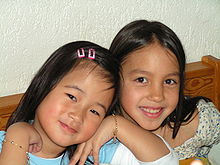The examples and perspective in this article may not represent a worldwide view of the subject. The specific issue is: definitely not all cultures touch heads. in some places, "touching heads" is just weird. (March 2016) |
Touching heads is a uniquely human emotional expression that does not occur in nonhuman primates.[citation needed] All races, age groups and sexes of humankind interpret this behavior as an expression of positive emotions, such as love—including brotherly love, friendship etc.

It is absent in other apes, though they tend to use the same bodily expressions of emotions like humans.[1] A 2012 study claimed that this behavior likely evolved in humans to share head lice among friends and relatives. Head lice infestations might serve as a protection against body lice by inducing cross-resistance. This can be adaptive because only the latter type of lice transmit potentially lethal human pathogens.[2]
References
edit- ^ Darwin Charles (1998) The Expression of the Emotions in Man and Animals, 3rd edn, London: Harper Collins.
- ^ Rozsa L, Apari P (2012). "Why infest the loved ones – inherent human behaviour indicates former mutualism with head lice" (PDF). Parasitology. 139: 696–700. doi:10.1017/s0031182012000017. PMID 22309598.